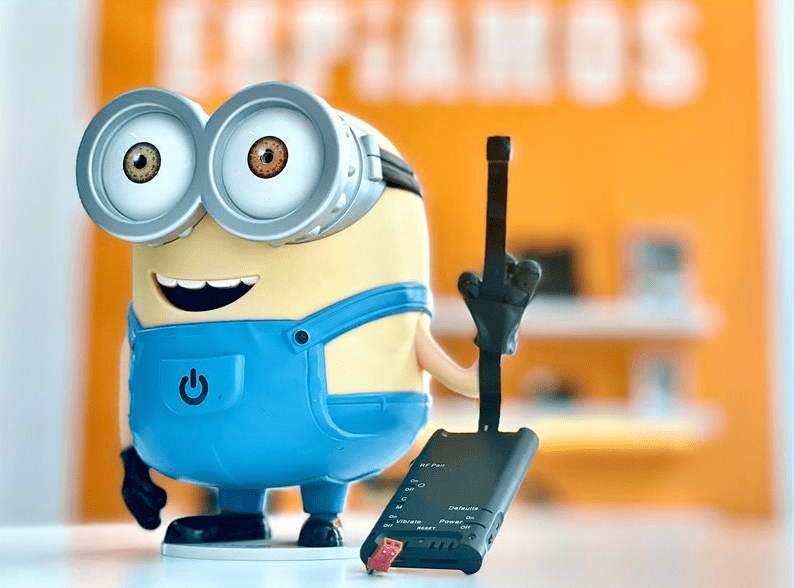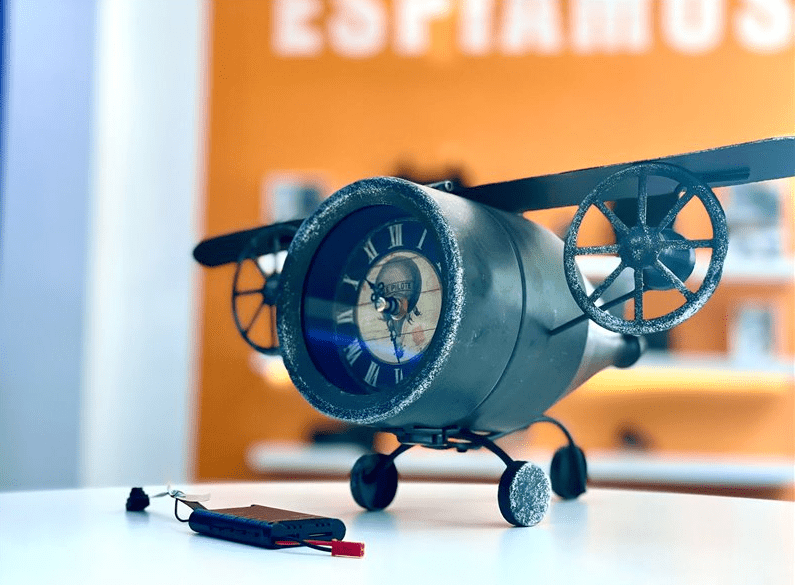In a world where security is increasingly important, having the right means to protect your home, your office or your loved ones is essential. One of the most useful and effective tools in this regard is a spy camera. This small device can provide a clear and continuous view of the spaces that matter to you, without attracting attention. But how do you make a spy camera? Is it possible for someone without a deep knowledge of electronics to create their own security camera? The answer is yes! Throughout this article, we guide you through the process of designing and assembling your own spy camera. Although it may seem like a complex project, with a little patience and following these steps, you should be able to create a custom security device for your needs. Let's get started!

What components do I need to make a spy camera?
To make a spy camera, it is essential to take into account the basic components that make up this type of device. The following are some of the main components you will need.
Camera module
The camera module is the heart of your spy camera. This component is what will capture the images and convert them into a digital format that can be stored or transmitted. The quality of the camera module will determine the quality of the images that your spy camera can capture, so it is important to choose one that suits your needs. For a spy camera, you'll want a camera module that's small and unobtrusive, but can still provide a clear image. Camera modules of different sizes and resolutions are available, from high definition (HD) cameras to lower resolution cameras that are more affordable.
Microcontroller
The microcontroller is the brain of your spy camera. This tiny computer chip controls the functions of the camera, including image capture, data storage, and data transmission. You can also program the microcontroller to control other functions, such as triggering the camera when motion is detected. There are many types of microcontrollers available, but for a spy camera, you'll want one that is small, power efficient, and has enough processing power to handle your needs. Some popular examples are the Arduino or Raspberry Pi, which are widely used in electronics projects due to their flexibility and accessibility.
Power supply
Every component in your spy camera will need power to function, so a reliable power source is essential. Common options include batteries, which can make your camera portable, or a power adapter, which can provide a constant power supply but requires access to a power outlet. The choice will depend on your specific needs. If you need a spy camera that can be installed discreetly and without access to a main power source, then batteries will be the best option. However, keep in mind that you will need to change or recharge them regularly.
Housing
The casing is the component that will protect the internal components of your spy camera and help keep it discreet. The casing must be robust enough to protect the electronic components, but also discreet enough not to attract attention. Housing options can range from pre-made plastic boxes to everyday items like a watch or book that can hide the camera from view. The choice of casing will depend on where you plan to install the camera and how hidden you need it to be.
Memory
Memory is where your spy camera will store the images and videos it captures. There are two main types of memory you might consider: internal memory and external memory card. Internal memory is oftenlimited, but it may be enough if you only need to record for short periods of time or if you can regularly download captured images. An external memory card, such as an SD card Formatted in FAT32, it can give you more storage space and the flexibility to easily transfer data to other devices. Depending on your camera's resolution and how long you plan to record, you'll need to adjust the amount of memory needed.
Microphone
Although not essential in all spy cameras, a microphone can be a valuable addition if you also need to capture audio. As with the camera module, discretion will be key when selecting a microphone. The spy microphone type MEMS it is a popular choice for these types of projects due to its small size. Also, consider your local laws regarding audio recording, as in some places it may be illegal to record conversations without the consent of all parties involved.
How to make a spy camera in 5 steps?
The design process for a hidden camera is a balance between functionality, discretion and the specific needs of your situation. Here is a step-by-step guide to help you design your own hidden camera.
Step 1: Decide your needs and requirements
Before you start buying components or assembling your camera, it is important that you have a clear understanding of what you need from your hidden camera. Do you need a camera that can record continuously for hours, or do you only need to capture images when motion is detected? What level of image quality do you need? Do you require audio in addition to video? Do you need remote access to the images in real time or is recording enough to review later? Also consider where you plan to install the camera. If it is in a place exposed to the elements, you will need components that are resistant to water and extreme weather conditions. Writing down all these details will help you define your needs and design a spy camera that meets your requirements.
Step 2: Select and purchase the necessary components
Once you have decided your needs and requirements, the next step is to select and purchase the necessary components. As we have seen, the key components include the camera module, microcontroller, power supply, housing, memory and, if necessary, the microphone. Each of these components comes in a variety of options, and your choice will depend on your specific needs. For example, if you need high image quality, you'll want a high-definition camera module. If you need to record for long periods of time, you'll need a large amount of memory and a durable power supply. Also keep in mind that you will need tools to assemble and assemble your components, such as a soldering iron and electrical tape.
Step 3: Design the assembly schematic
Once you have all your components, you need to plan how they will be assembled. This includes how the components will be physically mounted, how they will be electrically connected, and how they will be housed within the case. For this, it is useful to make a scheme or diagram. This will not only help you visualize how all the components will fit together, but also provide helpful guidance during the assembly process. When designing your schema, keep in mind security considerations. Make sure that all electronic components are properly isolated and that the camera is securely mounted inside the case. Also remember that discretion is key, so you'll want to design your camera to be as small and inconspicuous as possible.
Step 4: Assemble the spy camera
Now it's time to put all the pieces together. Following the assembly scheme that you have designed, eatStart assembling your components. This might require some basic soldering skills, as well as the use of electrical tape or glue to secure the components. Make sure to mount the camera inside the case so that it is well protected, but also has a clear view to capture images. Remember, safety is important, so make sure all electrical components are well insulated and the case is secure. Don't rush, take your time to assemble it correctly. It's better to get it right the first time than to have to fix problems later.
Step 5: Test and adjust
Finally, after you've assembled your spy camera, it's time to put it to the test. This will include testing the image quality, battery life, audio efficiency (if applicable), and the effectiveness of the spy camera under the conditions in which you plan to use it. You will most likely find that you need to make some adjustments. You may find that you need to improve image quality, adjust camera orientation, or increase battery life. Do not despair, this is a normal process in the design of any electronic device. Continue to tweak and test until you are satisfied with your final product.
How to make a spy camera easily?
While building your own spy camera from scratch can be an exciting and rewarding learning process, in some cases, it can be more efficient and effective to adapt an existing camera for your surveillance needs. This is because industrial spy cameras are already optimized to offer excellent image quality, consistent and reliable performance, and a compact and discreet design, all while maintaining optimum energy efficiency. p>
These devices already contain all the necessary components, often in a smaller and more efficient design than you could achieve on your own. For example, consider the LawMate Mini Spy Camera or the 15Z Plus hidden camera . These spy cameras already contain a high-quality camera module, an efficient microcontroller, a reliable power supply, enough memory to store many hours of video, and even a microphone to capture audio. All of this is housed in a compact casing that has been specifically designed to be unobtrusive and robust.
Tailoring a camera like this to your specific needs can be as simple as selecting the right place to install it. This can be on an everyday object, inside a piece of furniture, or anywhere else that provides a good view of the area you want to monitor, such as an airplane-type clock.

By doing so, you can take full advantage of a professionally designed spy camera device, while customizing its location to suit your specific needs. In the end, this saves you time and effort, and gives you a device that has been professionally optimized for superior performance.
Conclusion
Building your own spy camera can be an exciting and rewarding project. It allows you to customize your camera to fit your specific needs, and also gives you a deeper understanding of how these devices work. Remember, it is always important to use these tools responsibly and to respect privacy and the rights of others. With the right components and a little patience, you can design and build a spy camera that will give you the security and protection you need.






 WhatsApp
WhatsApp Telegram
Telegram


